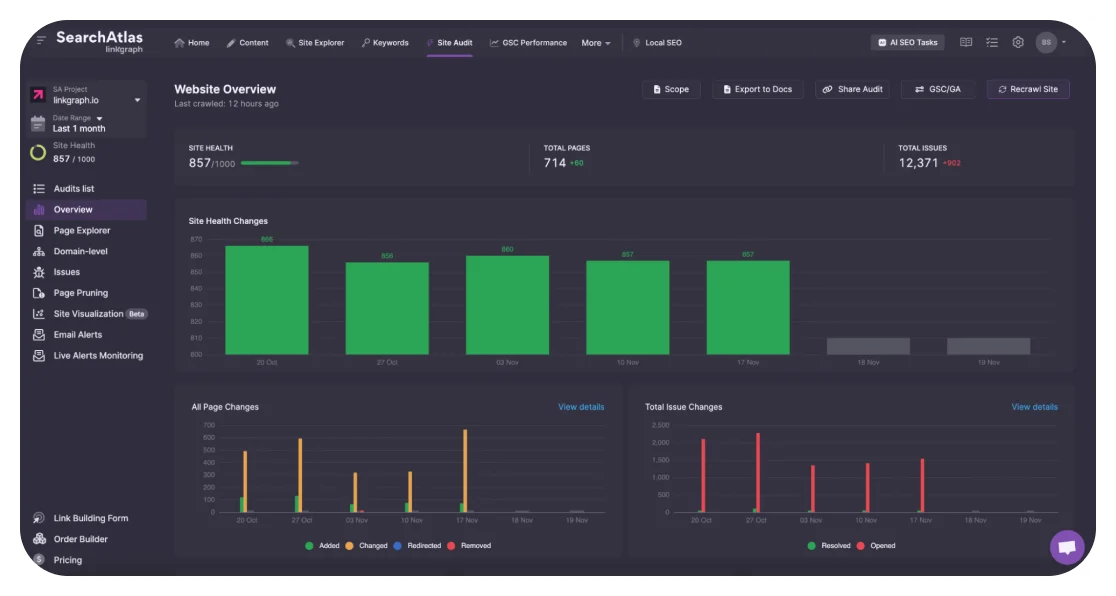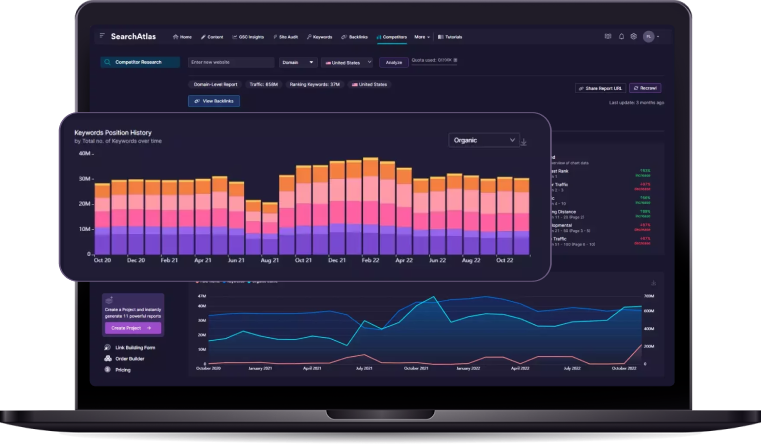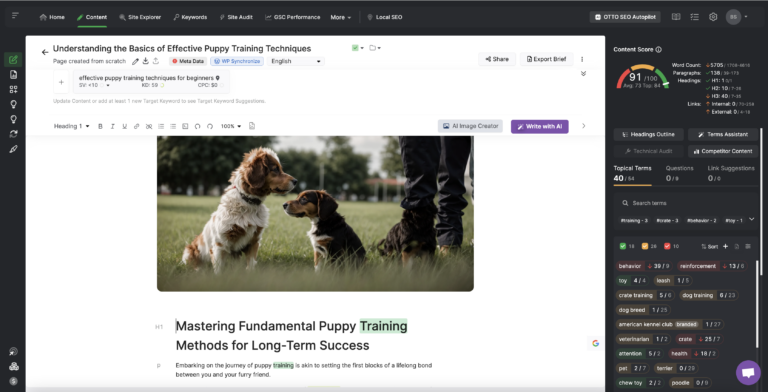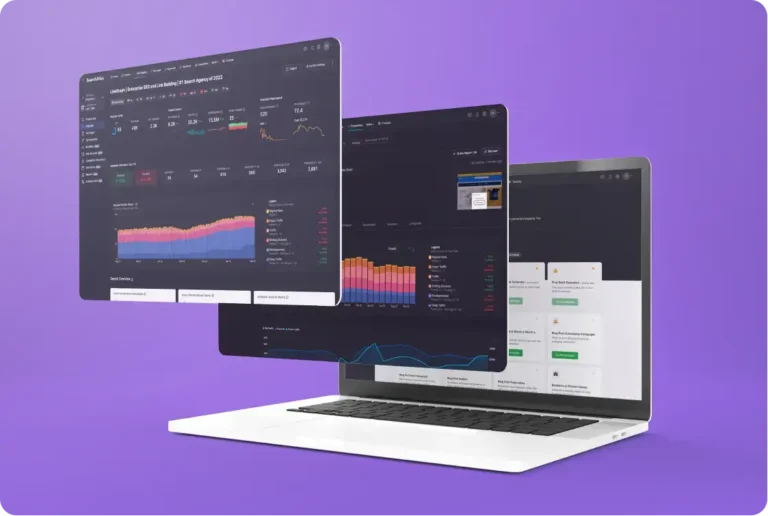Creating Compelling Content: Secrets to SEO-Friendly Blog Posts
In the digital realm, captivating your audience hinges on delivering not just content, but content that resonates with both search engines and human curiosity.
Beginning with a meticulous approach to keyword research, which uncovers the pulse of user intent, to constructing an article that strides confidently through the cluttered landscape of search results, mastering the art of SEO-friendly blog posts is an essential craft.
By intertwining the precision of Search Atlas tools with the creativity of content writing, experts fashion blog content that speaks directly to the searcher’s quest for information.
In this article, readers will unearth a trove of insights to transform a sterling idea into a magnet for target audience engagement.
Key Takeaways
- Keyword Research Is Foundational to Drafting SEO-friendly Blog Content, Involving an Understanding of Keyword Intent and Relevance
- Effective Use of SEO Tools Like Search Atlas Can Enhance Content Strategy and Uncover Relevant Phrases and Queries for the Target Audience
- Subheadings, a Well-Organized Outline, and Bullet Points Are Strategic in Creating Readable and Engaging Blog Structures
- Titles, Meta Descriptions, and Header Tags Are Crucial for on-Page SEO and Should Balance Keyword Inclusion With User Engagement
- Continually Updating Blog Content and Analyzing Performance Metrics Can Optimize SEO Efforts and Reader Experience
Kickstart Your SEO Journey With Keyword Research

Initiating the development of a search engine friendly blog post necessitates a foundational step that many SEO experts swear by: keyword research.
For those aiming to captivate and engage their target audience, appreciating the importance of identifying target keywords cannot be overstated.
This initial foray into SEO involves not merely compiling a list of relevant terms, but also delving deeply into the psychology behind keyword intent and relevance, ensuring content alignment with user needs.
Additionally, writers must tactically evaluate keyword difficulty alongside search volume, as these metrics influence the ability to rank in search engine results pages.
Indeed, this trifecta of keyword understanding lays the groundwork for drafting quality content that resonates with both the searcher’s quest and the intricacies of search engine optimization.
Identify Your Target Keywords
Embarking on the journey of SEO entails arming oneself with a well-researched array of target keywords that serve as lighthouses guiding the course of content creation. The endeavor of identifying these critical keywords demands an in-depth analysis using tools like Search Atlas, which illuminates the often opaque digital landscapes by offering insights into keyword popularity, competition levels, and user relevance.
With the usage of Search Atlas’ Keyword Research tool, businesses uncover the precise phrases and queries their audience employs, transforming guesswork into an evidence-based strategy. This granular dissection of language and searcher behavior empowers enterprises to curate blog posts and digital narratives that do not just engage but also convert readers into loyal customers.
Understand Keyword Intent and Relevance
A vital component of crafting SEO-friendly blog posts is unraveling the layers of keyword intent. By doing so, professionals can unearth the underlying reasons a user enters a specific search term into a search engine. Identifying whether the searcher is seeking information, comparing products, or ready to purchase is crucial for aligning blog content with the expectations and requirements of the target audience.
The relevance of a keyword goes beyond its frequency in search queries; it encompasses its congruence with the content’s subject matter. Here’s a strategic approach to this aspect:
- Assess the synergy between the keyword and the blog subject to ensure thematic consistency.
- Analyze search engine results pages (SERPs) to gauge the type of content that ranks for the chosen keywords, adapting the strategy accordingly.
- Employ the Search Atlas Topical Map to discover semantically related topics, fostering a robust network of relevance and authority within the content.
In this way, the relevance of keywords serves as the backbone of an SEO strategy, determining the trajectory of content creation and the potential to fulfill user intent, thereby enhancing the probability of higher SERP rankings and increased visitor engagement.
Assess Keyword Difficulty and Search Volume
Unlocking the potential of an SEO-friendly blog post hinges on evaluating the keyword difficulty and search volume, metrics that are emblematic of a term’s competitiveness and popularity. Writers are advised to leverage tools like Search Atlas’ Site Explorer and Keyword Research functionalities to ascertain these crucial data points, enabling a strategic approach to content planning that accounts for the balance between aspirational ranking goals and practical achievability.
Grasping the nuance between keywords that garner thousands of monthly searches and those that resonate with a niche audience is a discerning factor for success in digital marketing campaigns. By harnessing the Domain Authority Checker and Backlink Analyzer within Search Atlas, professionals glean insights into the authority needed to rank for certain keywords, thus tailoring content to intersect with both the volume of search activity and the receptivity of the intended target audience.
Craft a Solid Structure to Enhance Readability

Embarking on the quest to create an SEO-friendly blog post transcends mere keyword placement; it demands a thoughtful design of the article’s structure to amplify readability and retain visitor attention.
An intuitive structure not only invites the reader into the narrative but also facilitates the seamless consumption of information, catering to the fast-paced browsing habits of today’s audience.
By implementing strategic content segmentation with subheadings, sketching a logical blueprint through an outline, and breaking down complex points with bullet lists, writers elevate the reader’s experience to new heights of clarity and engagement.
As the architect of your textual canvas, such structural elements are vital in guiding the reader through your shared knowledge with a kind of finesse that both underscores your expertise and respects the reader’s journey of discovery.
Break Content Into Digestible Sections With Subheadings
Subheadings act as signposts within a blog post, directing readers through the text and highlighting the narrative’s pivotal turns. They serve not only to preview the upcoming content but also to offer respite in the reading journey, allowing for moments of reflection and connectivity with the writer’s insights.
Incorporating subheadings effectively is a delicate art that aligns the rhythm of prose with the user’s desire for a coherent path through the material. Subheadings should succinctly encapsulate the essence of the following section:
- Present a clear and concise summary of the upcoming paragraph or section.
- Entice the reader’s curiosity, encouraging further engagement with the content.
- Maintain a consistent style and tone, fostering a seamless reading experience.
These navigational cues, when utilized skillfully, can significantly elevate the user’s experience, transforming a mere scan of the page into a meaningful and informative reading session. They enhance the blog’s usability, ensuring that both skimmers and deep readers can extract value according to their personal engagement levels with the content.
Organize Thoughts Logically With an Outline
An impeccably organized outline is a building block of compelling content, serving as a roadmap that navigates both writer and reader through the complexities of a subject. It captures the major arguments and supporting details in a coherent sequence, thus ensuring that the narrative unfolds with logical progression and culminates in a satisfying conclusion.
Utilizing an outline, writers can methodically structure their ideas, guaranteeing a narrative that flows gracefully from introduction to conclusion. This preparation allows for the seamless integration of SEO elements, such as keywords and subheadings, which in turn elevates the final piece to meet the stringent demands of both search engines and discerning readers.
Use Bullet Points and Lists for Clarity
To enhance the user’s comprehension and retention, bullet points and numbered lists serve as indispensable tools in content creation. These elements distill complex information into digestible snippets, enabling readers to glean key insights with a quick scan.
Within the confines of an SEO blog post, integrating bullet points and lists transforms a potentially daunting text wall into an inviting space. This technique helps the audience assimilate information in a structured manner, ultimately empowering them to connect with the content on a deeper level.
Optimize on-Page Elements With SEO Best Practices

The art of fashioning a search engine-optimized blog post is not confined to exemplary content alone but extends to refining the various on-page elements that play a critical role in captivating an audience’s interest and boosting the visibility of the post on search engine results pages.
Creating enticing, keyword-rich titles, employing well-crafted meta descriptions, and strategizing the use of header tags collectively form a trinity of on-page SEO best practices that can significantly enhance the attractiveness and structural integrity of blog content.
These facets are the keystones of an SEO strategy, carefully intertwining the allure of language with the precision of technical elements to achieve a synergy that beckons both the searcher and the search engine algorithms.
Create Enticing and Keyword-Rich Titles
A title serves as the beacon for a blog post, drawing the attention of both search engines and potential readers. It is the crowning feature that convinces a searcher to click through and thus, it must strike the perfect balance between informative and compelling, containing the main keyword to signal relevance to the search engine algorithms.
Creating a title that is rich in keywords without sacrificing creativity is a nuanced task that SEO strategists master. This involves molding the title to resonate with the audience’s interests and queries, ensuring that it stands out amidst the vast sea of content within the search engine results pages (SERPs):
- Conduct thorough keyword research to anchor the title in terms that are both searched for and germane to the blog’s topic.
- Infuse the title with a hook that captivates the reader’s curiosity, aligning with the search intent behind the target keyword.
- Tailor the title to marry SEO efficacy with the unique voice of the brand, fostering identity within the digital sphere.
Employ Meta Descriptions to Improve Click-Through Rates
Meta descriptions serve as the concise summaries that provide searchers with a snapshot of the blog content’s essence. When crafted with clarity and relevance, these snippets can dramatically increase click-through rates from SERPs, acting as an enticing hook that motivates a searcher to explore the full narrative.
SEO professionals leverage the power of meta descriptions by incorporating the focus keyword and conveying the value proposition of the blog post within the character limit. This tactic aligns the goals of search engine optimization with the demands of user experience, resulting in a synergy that enhances both visibility and engagement.
Strategize the Use of Header Tags for Structure
Strategizing the use of header tags is fundamental for structuring an SEO-friendly blog post. Header tags (such as H1, H2, H3, through to H6) provide a hierarchal framework that organizes content in a way that is digestible for users and decodable by search engines. These tags aid in emphasizing the importance of sections, allowing search algorithms to grasp the outline and major topics of the blog content efficiently.
Professionals in the realm of SEO acknowledge header tags as more than mere formatting tools; they recognize them as critical components in the orchestration of content for optimal reader engagement and search engine recognition. Skillful deployment of header tags can signal topical depth, leading to a more intuitive navigation experience for users, and ultimately bolstering the blog’s performance within search engine results pages.
Write Content That Engages and Retains Readers

Enthralling an audience within the digital mediascape requires content that is not only found but fervently read and shared.
Crafting an SEO-friendly blog post that achieves this feat hinges on weaving together narratives that answer critical reader questions, providing intrinsic value that extends beyond the surface of the text.
This approach necessitates a mastery of storytelling techniques and the strategic application of persuasive language, all aimed at forging a stronger connection with the reader and inciting meaningful action.
Through thoughtful composition and skillful articulation, writers can erect an engaging tapestry of content that captivates the target audience and elevates the blog’s standing within the competitive framework of search engine results pages.
Focus on Delivering Value and Answering Reader Questions
Engaging the interest of readers within an ever-expanding digital universe is a formidable task, where success is often gauged by the ability to address their questions with precision and authority. To captivate and hold a user’s attention, content must surpass the basic provision of information and delve into the realms of providing actionable insights and comprehensive answers, thereby positioning the company as a trusted advisor in the reader’s quest for knowledge.
Professional writers recognize the significance of crafting content that does more than fill space on a webpage; it should resonate with the audience by tackling the queries that propel them to seek out a blog in the first place. Through meticulously curated blog posts that offer clarity on pressing issues, companies enrich the customer experience and encourage a deeper level of engagement, turning casual visitors into loyal advocates of the brand.
Employ Storytelling to Connect With Your Audience
In the digital age, storytelling emerges as an indispensable conduit for forging genuine connections with an audience. The craft of embedding narratives within blog content is a powerful technique, it deftly lures readers into a journey, engendering an emotional investment that transcends the transactional nature of mere information delivery.
By skillfully blending the art of storytelling with the precision of SEO, writers craft an immersive experience for their readers. Each tale, rich with the brand’s ethos and woven with strategic keywords, not only captivates but also reinforces the messages within a content marketing campaign, fostering a memorable bond between the brand and its audience:
| Storytelling Element | SEO-Friendly Integration | Outcome |
|---|---|---|
| Relatable Characters | Personas aligned with target audience | Increased reader identification with content |
| Emotive Plot | Engagement-driving keyword themes | Heightened reader interest and time on page |
| Meaningful Conflict | SEO-optimized problem-solution scenarios | Improved search relevance and user retention |
| Resonant Resolution | Keyword-rich conclusions and CTAs | Encouraged reader action and sharing |
Use Persuasive Language to Encourage Action
Embedding persuasive language within a blog post transforms passive readership into a dynamic interaction, compelling visitors to move beyond contemplation into decisive action. This potent form of communication strategically employs words that inspire confidence and trigger an emotional response, urging the reader toward a specific outcome, be it subscribing to a newsletter, making a purchase, or sharing the content on social platforms.
SEO-savvy writers wield persuasive language as a tool to elevate the impact of their content, infusing calls to action (CTAs) with verve that aligns with the reader’s journey and the overarching goals of the content marketing strategy. By interweaving persuasive cues seamlessly alongside SEO elements, a blog post could significantly amplify its persuasive power, optimizing the chances of converting readers into customers and advocates for the brand.
Fine-Tune Your Post With SEO Enhancements

In the quest to forge exceptional blog content that captivates and converts, one must venture beyond the mere crafting of words and venture into the fine art of search engine optimization.
Experts understand that the most magnetic blog post is a symphony of targeted language and calculated enhancements that collectively augment visibility and user engagement.
Professionals often focus on infusing posts with latent semantic indexing (LSI) keywords to elevate topic relevance, optimizing visual elements with descriptive alt text and filenames, and strategically weaving internal links to extend the user’s dwell time on the site.
Each practice is meticulously executed to ensure that every facet of the blog works in unison, driving a powerful SEO strategy that attracts, informs, and, ultimately, retains a dedicated readership.
Integrate LSI Keywords to Broaden Topic Relevance
The integration of Latent Semantic Indexing (LSI) keywords into a blog post is a strategic move that broadens the thematic grasp of the content while enhancing its relevance to a variety of search terms. LSI keywords are thematically related terms that search engines use to understand content depth and context, ensuring that the post captures a wider spectrum of user queries related to the primary topic.
By embedding these semantically related keywords, content creators can seamlessly expand the reach of their SEO efforts, enriching the blog post with a depth that transcends the limitations of a single keyword focus. This nuanced enhancement signals search engines that the content is not just topically relevant but comprehensive, bolstering its potential to rank higher in the search engine results pages (SERPs).
Optimize Images With Alt Tags and Descriptive Filenames
Visual content optimization is a pivotal aspect of SEO, with alt tags and descriptive filenames serving as indispensable tools in this arena. Alt tags, short for alternative text, provide context for images, aiding in accessibility for users and allowing search engines to index the graphical content effectively. Descriptive filenames, on the other hand, offer an additional layer of information, reinforcing the subject matter of the images and contributing to the SEO value of the blog post.
Equipping images with proper alt tags and carefully crafted filenames forms a synergy that goes beyond aesthetics, contributing to the SEO-friendly nature of a blog post. By ensuring that each image is well-described both visually and textually, professionals enhance the possibility of their content appearing in image search results, broadening the potential audience reach and bolstering the comprehensive appeal of their online presence.
Implement Internal Linking to Keep Users on-Site Longer
Implementing internal linking is an adept strategy to keep users engaged and navigating across various pages of a website for extended periods. By providing readers with relevant links to related content, companies encourage a deeper exploration of their site, which can lead to improved user experience and increased time on site – a factor that search engines may reward with higher rankings.
These strategically placed links serve as pathways inviting users to discover more content that piques their interest, enriching their overall site journey. While enhancing user experience, internal linking also distributes page authority throughout the site, bolstering the SEO profile of multiple pages:
- Links to high-value pages boost their visibility and authority.
- Interconnected content enhances topical relevance and coverage.
- User journey is diversified, reducing bounce rates and increasing engagement.
Maintain an Active Blog With Regular Updates

The digital marketing landscape is dynamic, with the continuous evolution of content playing a pivotal role in attracting and retaining an engaged audience.
Establishing an active blog necessitates a strategic approach that goes beyond sporadic posting, fostering a systematic pipeline of compelling content.
To compete in an increasingly congested digital space, a blog must demonstrate vitality through consistent updates, reinforcing relevance and establishing domain authority.
The following outlines strategic actions—developing a content calendar, rejuvenating stale offerings, and leveraging analytics—to enhance the propelling mechanism of blog success in alignment with search engine preferences and reader expectations.
Develop a Content Calendar for Consistent Posting
An essential strategy for sustaining an active blog involves the creation of a content calendar that outlines a schedule for regular publication. This proactive planning tool allows marketing teams to map out topics, deadlines, and responsibilities, ensuring a steady stream of engaging blog content that strengthens SEO efforts and keeps readers returning for more.
By adopting a systematic approach to content delivery via a well-structured content calendar, businesses solidify their commitment to delivering timely and relevant blog posts. This disciplined cadence not only builds reader anticipation but also signals to search engines that the website is a current and authoritative source within its field, potentially boosting SERP rankings and online visibility.
Refresh Old Content With Updated Information
Keeping blog content fresh is an ongoing endeavor that requires revisiting and reviving previous posts. Updating old content with new insights, statistics, and developments not only reaffirms relevance but also can reignite a post’s potential, thereby re-engaging an audience with revitalized material.
Strategic content refreshment ensures that a blog remains a vibrant, evolving repository of information, reflective of the latest trends and data. By imbuing older posts with current information, businesses enhance Search Engine Optimization, making it more likely for these rejuvenated articles to perform well in the search engine results pages:
| Action | Benefit |
|---|---|
| Integrate Latest Research | Upsurges post’s value and authority |
| Update Meta Descriptions | Improves click-through rates from SERPs |
| Revise Keyword Strategy | Aligns post with up-to-date search trends |
When executed effectively, this process of content refurbishment serves as an SEO technique, elevating a blog’s overall standing by ensuring all posts, new and old, share equal opportunities to attract and inform readers.
Analyze Performance and Iterate to Improve Future Posts
Maximizing the performance of blog content is an intricate dance of analysis and adaptation. By diligently monitoring key performance indicators such as page views, bounce rates, and engagement metrics, businesses can pinpoint the strengths and weaknesses within their SEO tactics and user experience designs.
Infusing iterative improvements based on this analytical data ensures that future posts are tailored to audience preferences, fostering content that not only ranks well but also resonates more profoundly with readers:
| Performance Metric | Analysis Focus | Iterative Action |
|---|---|---|
| Page Views | Determine content popularity | Refine topics and promotion strategies |
| Bounce Rates | Assess engagement and relevance | Enhance on-page SEO and content quality |
| Engagement Metrics | Evaluate user interaction | Adjust calls to action and user experience |
By perpetually refining SEO strategy and content offerings through the lens of performance analytics, businesses craft a blog that dynamically evolves, meeting the shifting landscapes of both search engine algorithms and user expectations.
Frequently Asked Questions
How can i use keyword research to improve my blog’s seo performance?
Keyword research is vital for enhancing a blog’s SEO performance as it allows writers to identify the terms and queries their target audience is searching for. By integrating these keywords into high-quality, readers-focused content, one can improve the blog’s visibility in search engine results pages, ensuring that the content resonates with user intent and reaches the right audience.
What are some tips for creating a structure that enhances the readability of my blog posts?
To enhance the readability of blog posts, ensure that the structure includes clear and concise headings, subheadings, and short paragraphs which guide readers through the content. Additionally, incorporating bullet points and numbered lists where appropriate can enable the audience to process information more efficiently, making for a user-friendly experience.
How can i optimize on-page elements in my blog posts to improve search engine rankings?
Optimizing on-page elements in your blog posts can significantly enhance search engine rankings by ensuring content is aligned with search intent, using strategic keyword placement, and improving the overall user experience. The use of comprehensive tools such as Search Atlas aids in meticulous auditing and optimization to meet the criteria set by search engines, which, in turn, elevates the visibility of your content on search engine results pages.
What strategies can i employ to write engaging content that keeps readers coming back?
Engaging content is crafted through a harmonious blend of relevance, readability, and catering to searcher’s needs, enhanced by compelling storytelling that resonates with the target audience’s interests and questions. By embedding Search Atlas tools in the writing process, writers can harness advanced SEO techniques to ensure that the blog content not only captivates but also performs well in search engine results, gradually cultivating a loyal readership that values quality content and expert insights.
What are some seo-enhancements i should consider when fine-tuning my blog posts for optimal performance?
When enhancing blog posts for optimal SEO performance, consideration should be given to incorporating strategic keyword research and density, as well as ensuring the content aligns with user intent and search engine algorithms. It is also essential to include meta descriptions, relevant subheadings, and alt text for images to improve both readability and search engine rankings.
Conclusion
Creating compelling, SEO-friendly blog content is pivotal for captivating audiences and boosting search engine rankings.
It starts with meticulous keyword research, identifying the exact terms audiences use, and understanding user intent to ensure the content aligns with their needs.
Writers must also evaluate keyword difficulty and search volume to balance attainability with search activity.
Structuring posts with clear subheadings, logical outlines, and bullet points heightens readability and satisfies fast-paced browsing habits.
On-page SEO, like crafting keyword-rich titles, meta descriptions, and strategic header tags, is essential for attracting and search engine algorithms.
Engaging storytelling and persuasive language connect with readers, encouraging them to take action.
SEO enhancements, including LSI keywords, optimized visual elements, and internal linking, amplify post visibility and user engagement.
Maintaining an active blog with a consistent posting schedule through a content calendar, refreshing old content, and analyzing performance to iterate improvements are crucial for an evolving digital presence.
By synthesizing these elements, businesses create SEO-rich, engaging content that resonates with both search engines and the target audience.









